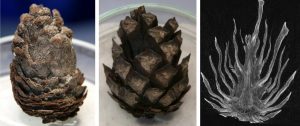
Fossil conifer cones can still move their individual seed scales after millions of years. This is the finding of a study conducted by the biologists Dr. Simon Poppinga and Prof. Dr. Thomas Speck from the Plant Biomechanics Group and Botanical Garden of the University of Freiburg.
The cones analyzed in the study therefore represent the oldest known plant structures that are still capable of movement and can also serve as a model for bioinspired technical applications with low maintenance requirements. The researchers published their findings in the journal Scientific Reports.
Cones from coniferous trees like pines open in response to dry conditions and close in response to wet conditions — a mechanism that enables them to release their seeds under favorable environmental conditions. In addition, the movement of the individual scales is passive, meaning that it does not require any metabolic energy.
These attributes have recently brought conifer cones to the attention of scientists, who aim to use them as biological models for the development of technical devices capable of autonomous movement.
Poppinga and Speck have now discovered that the scales continue to function in this way for an extremely long time: Fossil cones from the Eemian interglacial period, about 126,000 to 113,000 years ago, as well as the middle Miocene, about 16.5 to 11.5 million years ago, still react to changes in moisture by moving their scales. With the help of x-ray-computed tomography, the researchers demonstrated that the cones are preserved by coalification during the fossilization process and that the fossilized cones show only very few mineral inclusions. This ensures that the fine structures responsible for moisture-dependent movement remain intact.
Reference:
Simon Poppinga, Nikolaus Nestle, Andrea Šandor, Bruno Reible, Tom Masselter, Bernd Bruchmann, Thomas Speck. Hygroscopic motions of fossil conifer cones. Scientific Reports, 2017; 7: 40302 DOI: 10.1038/srep40302
Note: The above post is reprinted from materials provided by Albert-Ludwigs-Universität Freiburg.










